What if the breach already happened?
12 Mistakes to Avoid During ISO/IEC 27001 Audits of Information Security Management Systems


Achieving ISO/IEC 27001 certification is a significant milestone for organisations committed to managing information security risks in a structured and globally recognised way. However, many businesses, regardless of size or sector, face challenges during audits not due to the absence of controls but because of oversights in preparation, application, or understanding of the standard’s requirements.
As a UKAS-accredited management systems certification body, Risk Associates has observed recurring patterns in audit nonconformities. Below, we outline twelve frequent missteps that organisations should avoid when preparing for ISO/IEC 27001 audits, helping ensure the assessment reflects the maturity and resilience of the Information Security Management System (ISMS).
Jump to
11 steps to PDPL complianceA common misconception in audit preparation is the belief that comprehensive documentation is sufficient to meet ISO/IEC 27001 requirements. While having policies, procedures, and records in place is foundational, auditors focus equally if not more on whether these documents are effectively implemented. Gaps often emerge when controls exist on paper but are not reflected in day to day operations. This disconnect typically surfaces through employee interviews, system walkthroughs, or lack of evidence showing routine usage of defined processes.
For instance, an access control policy may exist, but if staff are unaware of its application or responsibilities, it undermines its purpose. Auditors are not merely checking for the presence of policies they are validating operational consistency. ISO/IEC 27001 certification aims to confirm that information security is embedded into organisational culture and behaviours, not just managed through documentation. Failure to operationalise documented controls can lead to nonconformities and missed certification opportunities.
Without clearly defined roles and responsibilities, even the most well structured ISMS can fail to perform. Staff members may be unsure of their security related duties, leading to delays in reporting incidents, mismanagement of access controls, or lapses in compliance monitoring. This ambiguity not only weakens the overall ISMS but also signals to auditors that the organisation lacks a coherent governance structure.
Jump to
11 steps to PDPL complianceDuring audits, it is common to find cases where ownership of critical controls such as log review, backup validation, or risk assessments has not been formally assigned or communicated. ISO/IEC 27001 expects security responsibilities to be clearly established, communicated, and understood at all relevant levels. Without this clarity, organisations risk inconsistent execution of security practices which can ultimately impact the effectiveness and reliability of their information security management system.
Applying Annex A controls without aligning them with the organisation’s unique risk context is a missed opportunity. ISO/IEC 27001 requires that controls be selected based on a robust risk assessment not arbitrarily applied from a checklist. Using vague or templated justifications such as industry best practice or commonly used does not demonstrate an informed risk based approach.
Auditors will expect to see a rationale that clearly links each control to a specific threat, asset, or vulnerability. For example, if encryption is deployed, there should be a documented reason grounded in identified risks to data confidentiality. Generic justifications not only weaken the Statement of Applicability but also raise questions about how thoroughly the risk assessment was performed. Controls must reflect real world relevance to organisational objectives and operating environments.
ISO/IEC 27001 is built on a foundation of leadership engagement. Merely delegating security tasks to IT or compliance teams without active involvement from top management undermines the standard’s requirement for leadership commitment. Auditors will assess whether senior leadership is truly engaged in setting the direction for the ISMS, reviewing its performance, and allocating appropriate resources.
An incomplete or inconsistent risk assessment approach can have cascading effects across the entire ISMS. If risk criteria are ambiguous or asset inventories are outdated, the resulting controls may be either excessive or insufficient. A strong risk assessment is central to ISO/IEC 27001 as it not only drives control selection but also shapes the overall security posture of the organisation.
An incomplete or inconsistent risk assessment approach can have cascading effects across the entire ISMS. If risk criteria are ambiguous or asset inventories are outdated, the resulting controls may be either excessive or insufficient. A strong risk assessment is central to ISO/IEC 27001 as it not only drives control selection but also shapes the overall security posture of the organisation.
Objective evidence is the cornerstone of audit verification. Providing verbal assurances or theoretical explanations without supporting documentation fails to meet audit expectations. Evidence may include logs, screenshots, system configurations, internal emails, meeting minutes, or training records that validate that the control has been implemented and maintained effectively.
In many cases, organisations claim that certain controls are in place such as periodic access reviews or backup testing but fail to produce documented proof. Without tangible evidence, auditors are unable to verify compliance, leading to findings or even nonconformities. ISO/IEC 27001 operates on the principle of say what you do, do what you say, and prove it. Neglecting this final step proof is a critical mistake.
ISO/IEC 27001 is not a one off project but a continuous cycle of improvement. One of the most common pitfalls is treating the standard as a checklist to be completed for initial certification rather than as an ongoing framework for managing information security. This mindset leads to gaps in routine control reviews, outdated risk assessments, and declining employee engagement over time.
Auditors will evaluate how well the ISMS has been integrated into the business’s day to day operations. If they observe that updates only occur around audit time or that monitoring and improvement activities are reactive rather than proactive, they may question the sustainability of the system. ISO/IEC 27001’s Plan Do Check Act model expects organisations to continuously assess and evolve their controls. Without regular reviews and updates, even a certified ISMS can become obsolete and ineffective.
Many organisations limit their audit scope to corporate IT environments while overlooking Operational Technology systems or third party service providers. These are often the weakest links in the security chain. OT systems particularly in sectors like manufacturing, energy, or logistics may have limited protections or lack segregation from business networks. Likewise, vendors or outsourced services may have access to sensitive data but operate without adequate controls.
Auditors will scrutinise whether third party and OT risks are being identified, assessed, and managed effectively. Failure to include them in scope can result in major blind spots. ISO/IEC 27001 requires consideration of external and internal issues that affect the ISMS which includes supply chains and non IT systems that support core operations. Comprehensive scoping and risk assessment are crucial for ensuring complete and meaningful audit coverage.
In many audit scenarios, organisations present well prepared documentation to demonstrate that required controls are in place. However, the effectiveness of these controls is rarely demonstrated through data driven evidence. Simply having a process or control outlined in policy is not sufficient under ISO/IEC 27001 as auditors look for operational validation that these controls function consistently and deliver intended results.
For example, if privileged access to sensitive systems is controlled through policy, evidence such as access logs, periodic review records, and audit trails must support this. An absent review history or failure to investigate repeated unauthorised access attempts even if detected can result in serious nonconformities. In such cases, auditors assess not just what the policy says but whether the organisation proactively evaluates and refines its security measures. Control effectiveness must be measurable, monitored, and demonstrable over time.
An outdated or untested incident response plan is a significant red flag. ISO/IEC 27001 expects organisations to not only have documented plans but to demonstrate readiness through simulations, post incident reviews, and lessons learned. Failure to prepare for real world incidents such as ransomware attacks or data leaks can severely compromise organisational resilience.
During audits, the absence of incident records, communication logs, or testing outcomes often signals that the plan exists only in theory. Auditors will assess whether roles are clearly assigned, escalation paths are defined, and post incident learning is captured. Being able to demonstrate incident handling capability is vital not only for compliance but for reducing downtime and reputational damage in case of actual security events.
Internal audits are not just procedural obligations as they are essential for measuring ISMS performance and identifying areas of weakness. When internal audits are superficial or lack independence, they lose their value. Common signs include audit reports with generic findings, repetitive observations, or a lack of root cause analysis.
Auditors will evaluate the internal audit process for its objectivity, thoroughness, and relevance. They expect to see clear planning, evidence collection, and corrective action follow up. If the internal audit fails to simulate the depth of a certification audit, it provides little assurance of ISMS effectiveness. An underperforming internal audit function also signals to certification bodies that the organisation may be relying too heavily on external assessments instead of driving its own continuous improvement.
A critical but often overlooked error is attempting to seek guidance or implementation advice from certification auditors. ISO/IEC 17021, the accreditation standard for certification bodies, strictly prohibits consulting to maintain impartiality. When organisations attempt to extract recommendations from auditors, they unintentionally blur the line between assessment and consultancy.
This can compromise audit objectivity and potentially jeopardise the certification process. At Risk Associates, as a UKAS accredited certification body, we maintain clear boundaries between auditing and advisory services. While auditors may ask probing questions or highlight observations, they must not prescribe solutions. Organisations are expected to interpret findings independently or engage consultants who are not involved in the certification process to help implement solutions.
ISO/IEC 27001 is not merely a technical standard it is a strategic enabler that embeds information security into the fabric of an organisation. Avoiding these twelve mistakes allows organisations to present not just a compliant ISMS but a mature, resilient, and well integrated security framework. From operationalisation to internal auditing, each element of the ISMS must reflect both intent and execution.
As a UKAS accredited certification body, Risk Associates conducts impartial and robust audits to verify real world application of ISO/IEC 27001 principles. Preparing thoughtfully, engaging leadership, and embedding a culture of continual improvement are essential not just for passing audits but for achieving long term security goals. In the face of evolving threats, ISO/IEC 27001 compliance when pursued correctly offers confidence, capability, and competitive advantage.

LAUNCH
Managed Security
Service Provider
What if the breach already happened?